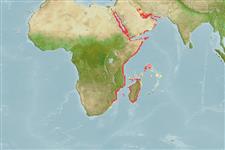| Native range |

|
| Pomacanthus maculosus AquaMaps Data sources: GBIF OBIS |
Length at first maturity
Lm 21.6 range ? - ? cm
Human uses
Fisheries: commercial; aquarium: commercial
Phylogenetic diversity index
(Ref. 82805)
PD50 = 0.5001 many relatives (e.g. carps) 0.5 - 2.0 few relatives (e.g. lungfishes)
Trophic Level
(Ref. 69278)
2.7 ±0.00 se; Based on food items.
Resilience
(Ref. 69278)
Low, minimum population doubling time 4.5 - 14 years (Preliminary K or Fecundity.)